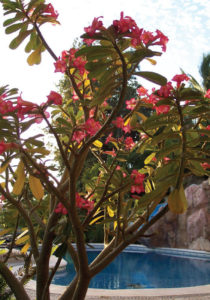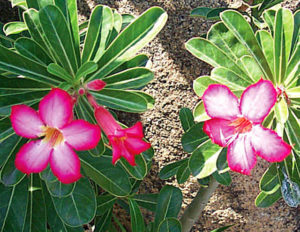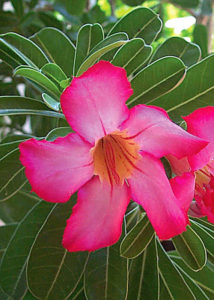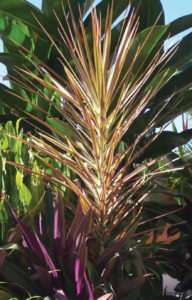Three beautiful options for your tropical garden in Mexico are the desert rose, dracaena and pothos.
Desert Rose (Adenium obesum)
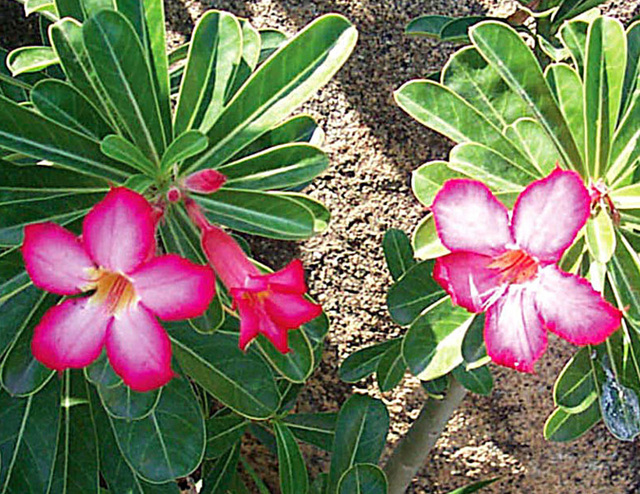
Family: Apocynaceae
Alternate names: Impala Lily, Desert Azalea, Sabie Star
Use: Related to the frangipani but more drought tolerant, this small shrub is evergreen. It grows to 6 feet high in the wild, but is usually smaller in cultivation, and is often dwarfed as a potted plant.
Flowers: The desert rose flaunts brilliant blooms of 2 inches or more in diameter, borne in terminal clusters. They range from pink to scarlet, with white and yellow centers. Adenium boasts a long flowering season. The plant does not usually form fruit in cultivation.
Cultivation: Keep warm and well-watered. Desert rose prefers partial shade and well-drained sandy soils. It can tolerate drought, and is a good choice for water-conserving gardens. It adapts readily to container culture. It is normal for this plant to lose leaves when it flowers.
Propagation: Desert rose can be propagated by seed, cuttings, or simply sticking dried-out branches in moist sand. The seedlings grow rapidly, and will generally flower within the first year.
Note: The sap is poisonous, anis used to coat arrowheads in the plant’s native range of Africa and the Arabian peninsula.
Dracaena (D. marginata “Tricolor”)
Family: Dracaenaceae
Alternate name: Money Tree, Rainbow Tree, Pleomele marginata, Dracaena concinna
Use: Dracaena is a member of the dragon tree family grown for its exotic foliage. It is grown as a border plant, or as a specimen. It shows well in massed plantings, and is also used as a potted plant in large tubs on patios and balconies. D. draco is the stout-trunked Dragon Tree; D.marginata has grey stems and narrow leaves; D. fragrans has heavy blue-grey ribbon-like leaves as long as 3 feet. It grows as a tree or shrub to as high as 20 feet.
Flowers: Seasonal white fragrant flowers occur in panicles above the leaves. Some cultivars have blooms of cream or pale green. The fruit of the dracaena is a yellow-orange berry.
Cultivation: Dracaena thrives in good well-drained soil in full sun to partial shade. It responds well to humid conditions, but let the soil dry between waterings. Prune the plant lightly to promote branching. In cooler climates, overwinter as a house plant, and inspect it for spider mites.
Propagation: Cuttings or air layering.
Pothos (Raphidophora aurea)
Family: Araceae
Alternate Names: Devil’s Ivy, Marble Queen, Epipremnum aureum, Scindapsis aureus
Use: Pothos is an attractive climber, with heart-shaped leaves splashed with yellow or white. Indoors, it is grown as a houseplant, climbing on support to as much as 10 feet. Most varieties are evergreen and variegated.
Flowers: The plant’s flowers are white to near-white. This plant is grown for its showy, variegated leaves.
Cultivation: Pothos should be cultivated indoors in rich organic soil, with low to moderate light and regular fertilizer applications. Inspect it often for pests. In gardens and parks, this extremely hardy climber prefers sun to part shade, and a well drained soil, regular water, and protection from wind, which tears the leaves. Gently prune away dead leaves and unattractive arial roots. Pothos contains toxic calcium oxalate crystals, which can be an effective insecticide. This plant is among the most efficient at helping to purify the air.
Propagation: Pothos is easily propagated by stem cuttings, leaf bud cuttings, layers, or by division.
Note: Pets eating the leaves will show irritation of the mouth.

